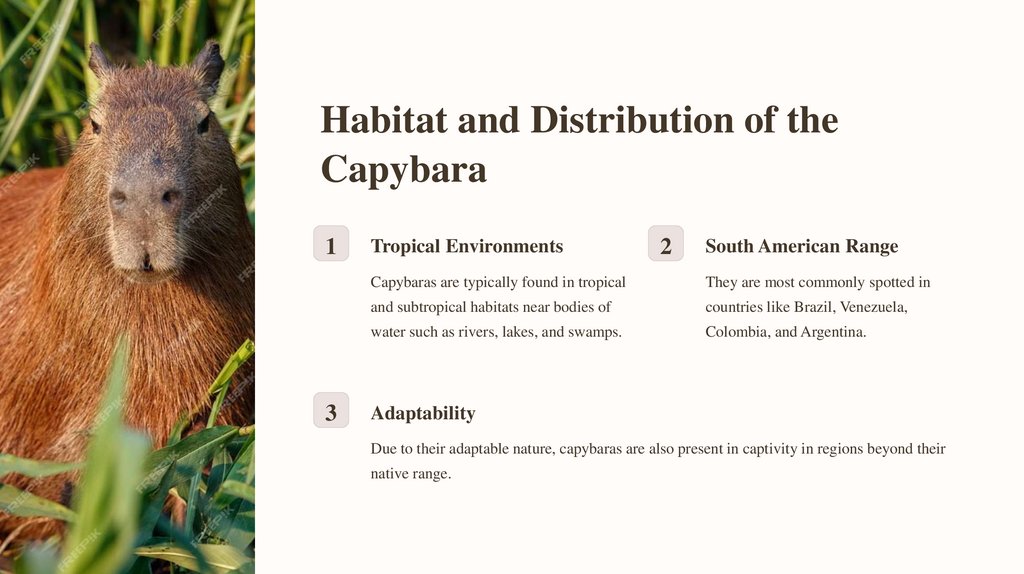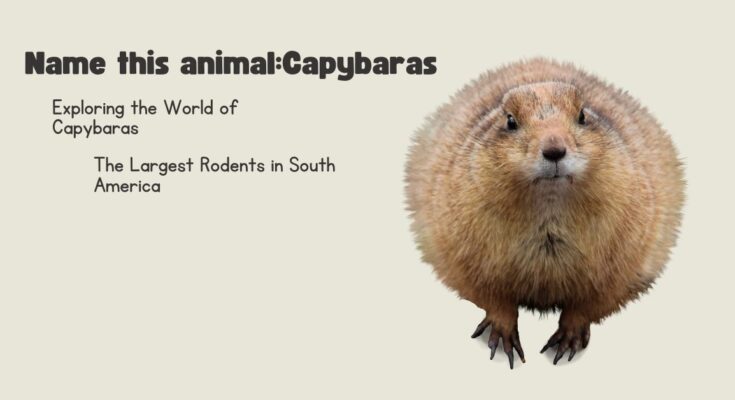Introduction to Capybaras
Welcome to the enchanting world of Capybaras, where nature’s most giant rodents roam freely in the lush landscapes of South America. Get ready to dive into their fascinating lifestyle, remarkable traits, and unique interactions with humans. Join us on this adventure as we explore the intriguing realm of these gentle giants!
Physical Characteristics and Behavior
| Attributes | Description |
| Large Size: | Adults typically weigh between 35 to 66 kilograms. |
| Barrel-shaped Body: | Covered in short, coarse hair ranging from reddish-brown to grayish-brown |
| Webbed Feet | Enables excellent swimming abilities and easy navigation in aquatic habitats. |
| Social Creatures: | Often found in groups of up to 100 individuals led by a dominant male. |
| Communication: | Vocalizations including barks, whistles, and purrs; use scent glands on their noses for marking territory and conveying information. |
| Diet: | Primarily herbivores, spending much of their day grazing on grasses and aquatic plants. |
| Territorial Behavior: | Can become territorial during the breeding season or when resources are scarce. |
| Unique Rodents: | Exhibit fascinating physical characteristics and complex social behaviors. |
| Peaceful Nature: | Generally gentle, but can exhibit aggression when necessary. |
Habitat and Distribution

He is the most giant rodent in South America and can be found in various habitats across the continent. These semi-aquatic mammals are commonly spotted near bodies of water, such as rivers, lakes, and marshes, where they feel most at home.
Their distribution ranges from countries like Brazil, Venezuela, and Colombia to regions including the Amazon Rainforest and the Pantanal wetlands. Capybaras are adaptable creatures that can thrive in both tropical and subtropical climates.
Whether lounging by the water’s edge or grazing on grassy plains nearby, capybaras have successfully carved out their niche in diverse environments. Their ability to navigate different terrains showcases their resilience as a species.
Despite human encroachment on their natural habitats through urbanization and agricultural expansion, They persist in various parts of South America. This adaptability adds to the mystique surrounding these fascinating creatures’ habitat preferences and distribution patterns.
| Diet and Feeding Habits |
|---|
| Capybaras are herbivores, primarily consuming grasses and aquatic plants. |
| They graze extensively, often during the early morning or late afternoon when temperatures are cooler. |
| Their sharp incisors enable efficient cutting through thorny vegetation. |
| Additionally, capybaras enjoy eating fruits and vegetables, adding variety to their diet. |
| During the dry season when food is scarce, they may consume bark and aquatic vegetation for nutrients. |
| Their feeding habits are crucial in shaping their environment by controlling plant growth near water bodies. |
| This contributes to the ecological balance in their habitats and benefits other wildlife species. |
| Capybaras exhibit versatility as herbivores, adapting well to feed on a diverse range of plant materials. |
Unique Adaptations for Survival
The giant rodents in South America have unique adaptations that help them thrive in their environment. One remarkable adaptation is their webbed feet, making them excellent swimmers and allowing them to escape predators by diving underwater.
Their eyes, nose, and ears are located on top of their heads so they can stay mostly submerged while keeping an eye out for danger. Capybaras also have a thick, water-resistant fur coat that helps regulate their body temperature and keeps them warm during colder nights.
Their capacity for vocalizations like whistles, barks, and purrs is another amazing adaption. These sounds help capybaras warn each other about potential threats or coordinate group movements when grazing.
These unique adaptations showcase the capybara’s incredible ability to survive and thrive in its natural habitat.
Human-Capybara Interactions
Imagine stumbling upon a group of capybaras leisurely lounging by the water’s edge, their eyes curiously watching your every move. These gentle giants are known to be quite friendly and may even approach humans with caution and curiosity.
Some people have had the incredible opportunity to interact closely with capybaras in wildlife sanctuaries or zoos, where they can observe these fascinating creatures up close. It’s important to remember that while they may seem friendly, respecting their space and natural behavior is crucial for their well-being and yours.
They coexist peacefully with local communities in some regions, grazing on grasslands alongside cattle or sharing watering holes. This harmonious relationship showcases the adaptability and tolerance of these remarkable animals in diverse environments.
Whether you’re observing them from afar in their natural habitat or getting a chance to interact under controlled conditions, human-capybara interactions offer a glimpse into the intriguing world of these charming rodents.
Conservation Efforts
Conservation efforts for capybaras are crucial in ensuring the survival of these gentle giants in the wild. Various organizations and researchers work tirelessly to protect their natural habitats, which are often threatened by deforestation and human encroachment. Conservationists aim to secure a future where these unique creatures can thrive by raising awareness about the importance of preserving capybara populations.
Efforts include monitoring population numbers, studying their behaviors to understand their needs better, and implementing measures to mitigate human-wildlife conflicts. Through education initiatives and community involvement, local communities are encouraged to coexist harmoniously with capybaras while respecting their habitats.
By promoting sustainable practices and advocating for the protection of wetlands and grasslands where capybaras reside, conservationists hope to safeguard these fascinating rodents and the delicate ecosystems they call home. The collective efforts towards conserving capybaras reflect a dedication to preserving biodiversity and fostering a balanced relationship between humans and wildlife.
Fun Facts and Misconceptions about Capybaras
Let’s dive into some fun facts and bust a few misconceptions about these fascinating creatures. Capybaras are known to be exceptional swimmers. They may remain underwater for as long as five minutes!
Despite their large size, capybaras are herbivores and feed on aquatic plants. They even have a unique digestive system that allows them to extract maximum nutrients from their diet.
One common misconception is that capybaras are aggressive, but in reality, they are pretty social animals. They live in groups and rely on each other for protection against predators.
Capybaras have webbed feet that make them agile in water and on land. This unique adaptation helps them escape danger quickly when needed.
Another interesting fact is that baby capybaras, called “chulengos,” can walk just a few hours after birth! These little ones stick close to their mothers for safety until they grow older.
Next time you spot a capybara lounging by the water, remember these fun facts and appreciate these gentle giants for the incredible creatures they are!
Conclusion
Capybaras genuinely are fascinating creatures that have captured the hearts of many worldwide. From their unique physical characteristics to their social behavior and adaptations for survival, these gentle giants never fail to amaze us.
As we continue to explore and learn more about capybaras, it is crucial that we also strive to protect them and their natural habitats. Conservation efforts are vital in ensuring these incredible animals thrive for generations.
So next time you find yourself near a body of water in South America, keep an eye out for these friendly rodents lounging by the shore or grazing peacefully on grassy plains. Take a moment to appreciate the beauty and complexity of the world of capybaras – the giant rodents in South America.




